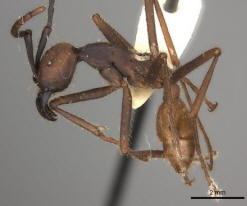The Army Ant (Eciton burchellii)
The Army Ant (Eciton burchellii)
is the most common species of ant in the Eciton genus.
It gets its name from its behavior of expansive, organized, and
fierce swarm raids to predate species that are usually much
larger than a single individual in the colony (BBC
2013).
That’s right; this ant is a predator, and one colony of
this predator can exceed
half a million individuals. When in collaberation, these
little guys can capture over
30,000 prey items in a day (Encyclopedia
of life 2013).
These are clearly not your average ants!

The average worker ant ranges from
3-12mm in size with
long, hook-shaped mandibles. The elongated
orientation
of their body and legs give them the look of a
common spider. They need a completely
carnivorous diet to sustain the larval
growth and
development with a high fat consumption. Their color
ranges from
a golden color to a dull brown, and they
can sting (Animal
diversity 2012)!
Some names used in local areas for Army Ants that thrive in
those areas are padicours, tuocas, tepeguas, and soldados.
In English, they are also called foraging ants, legionary ants,
soldier ants, and visiting ants (Antwiki
2013).
Here is another eusocial insect species to consider after looking
at Eciton burchellii:
Saharan Silver Desert Ant (Cataglyphis bombycina).
To see more websites on organisms like Eciton burchellii,
visit
Multipleorgansm.net
Go to Classification